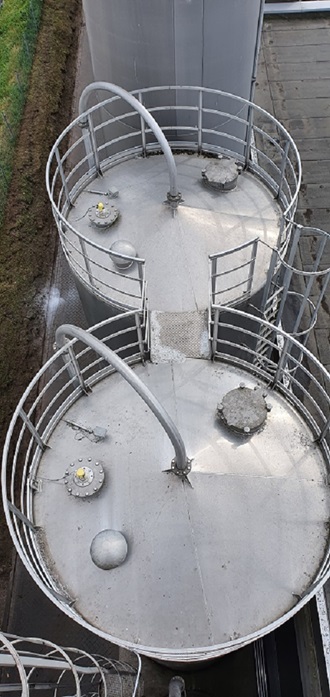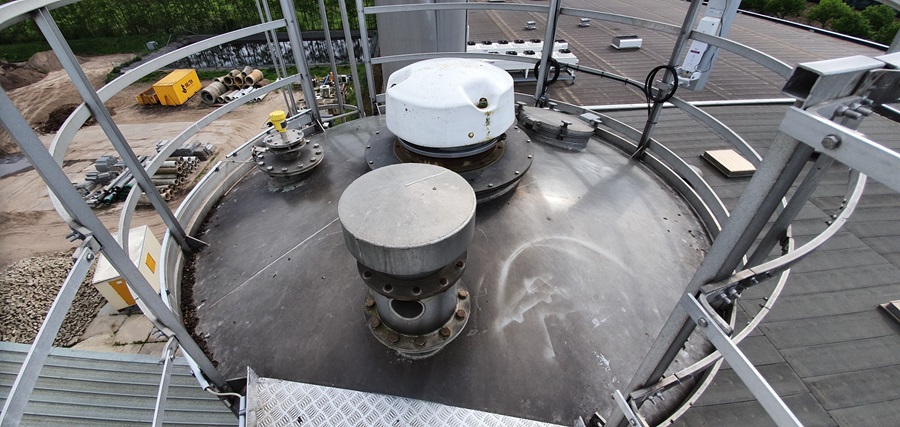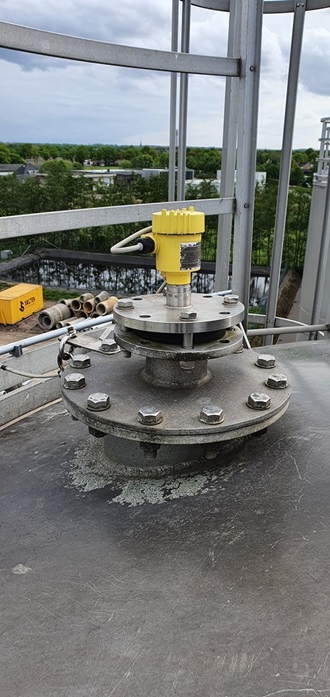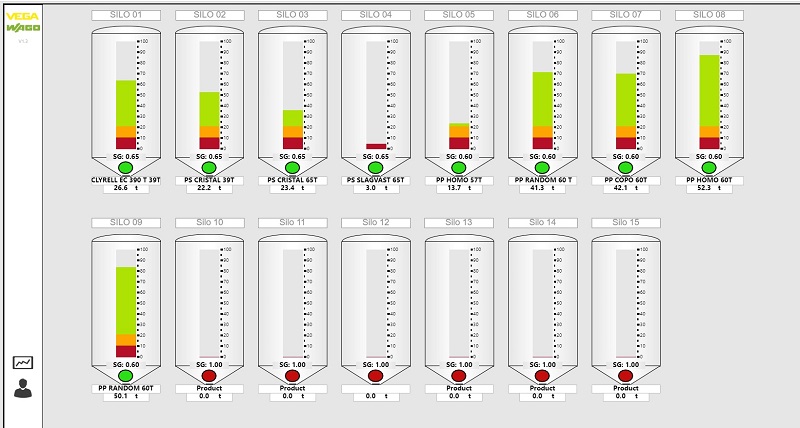Sensors from VEGA ensure reliable material supply in injection moulding machines
Perfectly shaped
Injection moulding machines deliver top performance in production, but to do that they have to be continuously supplied with raw materials. A well-known Dutch company uses VEGA level sensors to keep an eye on the stocks of plastic granulate in the raw material silos.
For over 30 years Haval BV has had a reputation as a responsible manufacturer of single-use items and packaging materials for the food industry, such as plastic glasses, cutlery, plates, stirrers and many types of food packaging. There are practically no limits when it comes to form, function and colour. Yet the company, which is now active internationally, started out in a completely different line of business – it was originally a cafeteria. One of its regular customers at the time owned an injection moulding machine that was no longer in use and just gathering dust. The customer asked Haval if it wouldn’t like to use the machine to make its own chip forks. The answer was yes, and shortly afterwards two wholesalers from the catering industry asked if they could be supplied with the forks as well. The answer was again yes! This was the decisive turning point in the company’s history – it changed from a cafeteria to a manufacturer of single-use items and packaging for the food industry.
Continuous innovation in production techniques has made Haval a specialist in this field today. Every year around 5 billion single-use items and packagings leave the state-of-the-art production facility in Gemert, the Netherlands, and make their way to customers all over Europe. All products are developed in collaboration with reputable design agencies, focusing not only on design but also on the physical product requirements. As regulations are changing in the European Union, single-use items will be banned from 2021 onwards. However, Haval has long been placing emphasis on another mainstay, namely the production of food packaging used, for example, for the storage and sale of salads, vegetables, fruit, etc.
From the silo to the perfect shape
Whether disposable cutlery or packaging – the basis of all these products are high-quality plastic granulates of polystyrene and polypropylene. This raw plastic material is transported from the aluminium silos to the injection moulding machines, where it is melted and injected into the moulds under high pressure. The total volume of the nine storage silos is 900 m3. “To ensure reliable replenishment and smooth operation, we need accurate, trustworthy data on the quantities of plastic granulate in our stocks. If the raw material runs out, we would have to shut down one or more of our injection moulding machines,” explains Ron Kastermans, Production Manager at Haval BV. “We now rely on a combination of radar level measurement and VEGASCAN visualisation to keep that from happening.”
Multiple radar sensors of type VEGAPULS 68 and 69 are used in the silos. VEGAPULS 68 has been in use in two silos for more than seven years and still works perfectly. VEGAPULS 69 was installed in the other three silos. “The greatest challenge for level measurement was the low dielectric constant of the raw material – the plastic granulates have a Dk value of around 1.2”, explains Ron Kastermans further. “Another problem faced by the sensors was the dust generated by polystyrene. Yet it cannot be avoided, as polystyrene is one of the main materials we process.”
Before VEGAPULS 69 was introduced, the level was measured with a sensor based on the guided microwave measuring principle. This worked, to be sure, but as soon as interference signals had the same magnitude as the level echo, reliable measurement was not always possible. Unfortunately, this situation occurs with many plastic powders and granulates. Their very low Dk values generate only weak reflections, as a large part of the radar signals is absorbed by the medium. Besides that, there are often interfering signals produced by plastic-specific fixtures and components installed inside the silos. Plastic powder is usually stored in high, very slender containers. Circumferential weld seams, even if they are only a few millimetres in size, often cause interfering reflections in such silos. In the worst case, there could be a weld seam every 50 cm, which would generate enough interference to completely drown out the useful signal. For Kastermans, ensuring the reliability of the measuring signal has top priority. “The most important thing for me in everyday operation is good measurement. It’s not even about having the very highest level of accuracy, but getting a continuous reliable result without malfunctions.”
Before VEGAPULS 69 was introduced, the level was measured with a sensor based on the guided microwave measuring principle. This worked, to be sure, but as soon as interference signals had the same magnitude as the level echo, reliable measurement was not always possible. Unfortunately, this situation occurs with many plastic powders and granulates. Their very low Dk values generate only weak reflections, as a large part of the radar signals is absorbed by the medium. Besides that, there are often interfering signals produced by plastic-specific fixtures and components installed inside the silos. Plastic powder is usually stored in high, very slender containers. Circumferential weld seams, even if they are only a few millimetres in size, often cause interfering reflections in such silos. In the worst case, there could be a weld seam every 50 cm, which would generate enough interference to completely drown out the useful signal. For Kastermans, ensuring the reliability of the measuring signal has top priority. “The most important thing for me in everyday operation is good measurement. It’s not even about having the very highest level of accuracy, but getting a continuous reliable result without malfunctions.”
The measuring situation in the plastics industry, which had been unsatisfactory for many years, only started to improve a few years ago when VEGA introduced VEGAPULS 69 to the market. This instrument operates with a transmission frequency of 80 GHz and has an antenna diameter of approx. 75 mm. This allows significantly better focusing of the transmission signal and a beam angle of only 4° – ideal for slender, tall silos. By comparison: A radar sensor with 26 GHz transmission frequency and an antenna of the same size operates with a beam angle of approximately 10°. The good focusing helps to better separate the actual measurement signal from interference signals. It was made possible by new microwave components that can detect even the tiniest reflected signals.
Higher dynamics
A second aspect that has in the meantime won over many users to VEGAPULS 69 is its dynamic range. In the case of radar sensors, this parameter, i.e. the difference between the largest and the smallest signal, determines which applications the sensor can be used in. The greater the dynamics, the wider the application range of the sensor. Thanks to the large, 120 dB dynamic range of VEGAPULS 69, even the tiniest reflections can be picked up and measured. And in the case of media with poor reflective properties, this feature makes it possible to measure them at all.After radar level sensors were first used successfully in five raw material silos, three more silos were put into operation in May 2018 and four more radar sensors from VEGA installed. At this point, Haval also decided to go one step further and introduce an inventory management system for the raw materials. Until then, inventory management had basically been done “by hand.” To be on the safe side, the company always kept on hand a supply of around 200,000 kg of raw material in sacks. Now it wanted to have a better overview of the raw material stocks.
Visualisation
For that reason, the VEGA sensors were supplemented with a VEGASCAN 693, which keeps track of and visualises the current stocks. VEGASCAN 693 is a universal controller for a variety of measuring tasks such as level, gauge and process pressure measurement that offers the option of connecting up to 15 independent VEGA HART sensors. It is particularly suitable for applications in the areas of inventory monitoring, VMI (Vendor Managed Inventory) and remote enquiry. Up to 200,000 measured values can be recorded and easily integrated into a company’s intranet. “With the additional visualisation it offers, we can easily track when a new delivery is made and which silo the delivery was unloaded into,” continues Ron Kastermans, naming just one reason for using VEGASCAN. And in conclusion he adds: “If an error actually occurs in our production, we can figure out very quickly the when and where, and which product we have to recall. This is a decisive advantage that helps us meet the strict requirements of the food industry.”Export this article
Download as PDFShare this article
Comments ({{comments.length}})
This article has no comments yet. Write the first one now!
{{getCommentAuthor(comment, "Anonymous")}} {{comment.timestamp | date : "dd.MM.yyyy HH:mm" }}
{{comment.comment}}
Write a comment
This field is mandatory
This field is mandatory
This field is mandatory
Invalid email address
This field is mandatory
Your comment must not contain any links or email addresses
This field is mandatory
Invalid captcha
untranslated: 'Blog_SendComment_Error'










